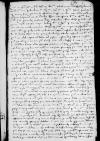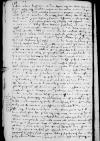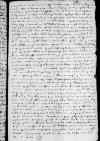Paulo ante cum ⌊cubiculario ⌊serenissimae maiestatis regiae⌋⌋ gratias Dominationi Vestrae Reverendissimae agens, quod iterum atque iterum facio, quae tum se offerebant, scripsi, cum hoc meo nuntio pollicitus copiosius scripturum me de omnibus. ⌊⌋ fasciculum illum litterarum ex ⌊urbe⌋
missum XXIII eiusdem mensis accepi[1], habeoque Dominationi Vestrae Reverendissimae, quod tam cito eum fasciculum ad me mitti curaverit, magnas gratias. In eo quae me spectabant non erant alia, quam quibus modis coadiutoriae negotium infectum ⌊Romae⌋ manserit etc.
De ⌊domino doctore Hosio⌋ ⌊⌋ me Dominationi Vestrae Reverendissimae, cui nihil negare vel debeo, vel possum, instrumentum cessionis missurum, quod iis adiunxi. Verum quomodo summus ⌊pontifex⌋ ad intercessionem ⌊serenissimae maiestatis regiae⌋ ius meum, quod nondum vacat, alteri conservare potuerit, non satis intelligo, cum nondum postulatio per ⌊capitulum Varmiense⌋ in me facta confirmationem sit nacta. Ego quidem
Dominationi Vestrae Reverendissimae, ut scripsi, neque velim, neque audeo quicquam negare, modo id fiat praeter indignationem ⌊serenissimae reginalis maiestatis⌋, quae prius ex me edocta est, cum pro ⌊palatinide Pomeraniae⌋ me urgeret, quod canonicatum meum servitori ⌊eius maiestatis⌋ a me iam pridem promissum domino ⌊Fabiano Woynowski⌋ reservarem. A quo promisso si declinarem, quam iterum turbam mihi excitarem facile Dominatio Vestra Reverendissima potest coniicere.
Accedit, quod etiam me angit, non solitum me mutare quod semel dixi. Neque satis bene sine meo posset fieri dedecore, adnixus enim sum semper, vel teste Dominatione Vestra Reverendissima, ne qua verbi a me tenacitas desiderari posset. Utcumque res habet, mitto cessionis instrumentum, quo, ut certam in Dominationem Vestram Reverendissimam fiduciam habeo, sic utetur, ne bene conservatae existimationi meae obsit, atque ne gravius aliquod odium rerumque mearum detrimentum conflare mihi possit. Non est Dominationi Vestrae Reverendissimae incognitum ⌊dominum doctorem Hosium⌋ ad ecclesiam Varmiensem habere nominationem; non incommode ut eius eventum expectaret consulerem. Ubi se is casus aliquando offeret, sancta fide Dominationi Vestrae Reverendissimae polliceor, cum et alias homini a primis annis mihi
noto ob optimas eius naturae dotes et cum paucis compensandam eruditionem sim benevolentissimus, illi operam et favorem meum non defuturum. Haec omnia in summam Dominationis Vestrae Reverendissimae prudentiam et in eam, qua me prosequitur, benignitatem immensam repono: fiat omne id, quod Dominatio Vestra Reverendissima voluerit.
⌊⌋, quibus in periculis eousque appulerit, in periculis viarum, fluminum atque etiam latronum, qui spoliatum et male affectum dimiserunt, et quod tum in ⌊Hispanias⌋
cf. Verg. A. 1. 204 per varios casus, per tot discrimina rerum / tendimus in latium, sedes ubi fata quietas ⌊per mille discriminacf. Verg. A. 1. 204 per varios casus, per tot discrimina rerum / tendimus in latium, sedes ubi fata quietas ⌋ difficillimis itineribus conferre se debebat. Et, cum ego multa experientia didicerim, quibus in malis is versatur, qui eiusmodi profectionibus intentus est, non possum non compati ac condolere in iis turbinibus et difficultatibus fluctuanti rebusque cum regiis tum etiam ⌊serenissimae reginalis maiestatis⌋ fideliter neque inutiliter inservienti. Rogavitque ⌊⌋, ne se deserere et a spe, quam de canonicatu meo concepit, decidere permitterem. Si aliquando,
cf. Juv. 10. 361 Herculis aerumnas credat saevosque labores; Lucil. 1350 30. 1062-1063 quantas quoque modo aerumnas quantosque labores / exanclaris ⌊post tot aerumnas exanclatosque laborescf. Juv. 10. 361 Herculis aerumnas credat saevosque labores; Lucil. 1350 30. 1062-1063 quantas quoque modo aerumnas quantosque labores / exanclaris ⌋, sospes,
quod spero, redierit, longe erit ad omnia regia atque item ⌊Reipublicae Regni⌋ et ⌊nostrae⌋ servitia aptior atque commodior. Ausim et hoc addere: si iterum aliquam hic sedium episcopalium, ut omnes mortales sumus, vacare contingeret, me neminem scire inter nostrates, qui ad praeficiendum illo magis foret idoneus. Haec non abs re scrib[o], ut Dominatio Vestra Reverendissima pro sua de futuris singulari dispicientia {ut} ista apud se providenter reputet, et, si visum fuerit, etiam principibus nostris suggerat, maiorem in modum oro, etc.
Misi hinc decretum postulationis ad manus domini ⌊Georgii Hegel⌋, et simile exemplum retinui, quousque ⌊reverendissimus dominus electus⌋ et ego aliquem ex nostris ad ⌊urbem⌋ mittamus cum auro et rebus aliis necessariis, addidique iis formam, qua ⌊serenissima maiestas regia⌋ ⌊summo pontifici⌋ et ⌊cardinali protectori⌋ pro nobis ut scribat, oranda est. Impense itaque oro Dominatio Vestra Reverendissima dignetur intercedere, quo istiusmodi litterarum binas seu, ut vocant, duplicatas habere possimus. Unas cum hoc
decreto postulationis ⌊procuratoribus nostris⌋ ⌊Georgius Hegel⌋ ⌊Romam⌋ mittet, ut, ne iacturam temporis
faciamus, interea tractare rem et formare incipiant, alteras cum auro et
nostro nuntio mittemus. Ut igitur eas meo huic tabellario ad me perferendas tradat, precor, aliis apud ⌊Georgium Hegel⌋ relictis, qui, quicquid cancellariae erit persolvendum, impendet. Opus praeterea habet litteris regiis dominus electus
⌊Tidemannus Gise⌋ ad ⌊capitulum meum⌋ et ecclesiae meae subditos ac ad totam Culmensem dioecesim, quibus ⌊serenissima maiestas regia⌋ significet ipsum in electum et futurum meum successorem constituisse. Et pro illis ⌊Georgius Hegel⌋ satisfaciet, ipse vero ⌊dominus electus⌋ et ego perpetuo Dominationi Vestrae Reverendissimae gratias sumus habituri, quantumque possumus relaturi.
Quae hic nova habemus, ⌊dominus Nibschicz⌋ orator noster a ⌊maiestate regia⌋ cum ⌊cubiculario⌋ scripsit. ⌊Is⌋ mihi multa amicissime retulit, hocque inter alia potissimum, quod quidam de primis ⌊Regni⌋ praelatis mihi bene maxime volens (nomen reticuit, quod tamen certa coniectura Dominationis Vestrae Reverendissimae esse deprehendi) cum eo de me rebusque meis plurima contulisset favens mihi,
cum iam pinguiorem essem fortunam assecutus, ut omnia mihi prospere et ex dignitate succederent. Quo tamen successus eiusmodi faciliores fierent, admonitiones quasdam multum benevolas ad me dedisse, quas, ut est dicendi non imperitus, verbis satis luculentis sententiisque vere philozophicis mihi est concionatus,
cf. Hor. Ars 304-305 fungar vice cotis, acutum reddere quae ferrum valet exsors ipsa secandi ⌊functus vice cotis, acutum reddere quae ferrum solet expers ipsa secandicf. Hor. Ars 304-305 fungar vice cotis, acutum reddere quae ferrum valet exsors ipsa secandi ⌋
, cumque finem fecisset, praeclare cognovi ex prioribus ad me descriptis Dominationis Vestrae Reverendissimae adhortationibus eas de
mente et propensissima voluntate Dominationis Vestrae Reverendissimae processisse, neque id victus a me dignis rationibus inficiari potuit. Quid illi responderim?
Primum fuit hoc, quod licet vix umquam magis pecuniarum quam hoc tempore
indigus fuerim, quo et ex ⌊urbe⌋ postulatio, et nescio quae alia mihi sint redimenda ac comparanda, tamen mille aureis adeo salutiferae benevolentissimaeque Dominationis Vestrae Reverendissimae commonitiones longe mihi essent gratiores atque cariores. Reliqua ipse dicet –
cf. Adagia 1526 No. 1245 Colophonem addidit ⌊in summa colophon fuitcf. Adagia 1526 No. 1245 Colophonem addidit ⌋. Sic me Deo optimo duce gessurum in omnibus, ut, quam maxime a me fieri potest, istiusmodi Dominationis Vestrae Reverendissimae doctrinae in me cognoscantur fructiferae fuisse et proficuae. Habeoque, si quibus umquam aliis in rebus, pro quibus plurimum debeo, tum praecipue pro iis paternis, piis amicissimisque com
monitionibus Dominationi Vestrae Reverendissimae gratias supra quam mortales, rogoque intentissime, ut numquam me eo paterno affectu et caritate prosequi desinat, sed semper ad me, si quid sciverit aut
audierit, quod vel statui, vel professioni meae non conveniret, id mihi
suggerat ob idque paterne me castiget emendatumque dimittat. Quibus pro rebus in animae meae salutem tendentibus multo plus quam pro iis, quae corpori et fortunis meis conducunt, quas habunde opera sua Dominatio Vestra Reverendissima mihi contulit, debebo eroque perpetuo astrictus.
Incidimus insuper in sermonem cum ⌊domino Nibschicz⌋ de vita eius et, quomodo iam non solum aetate, quae in dies fit grandior, sed etiam multis aulicis negotiis et otiis, quibus aula suo more solet abuti, sit attritus paeneque hinc corporis et animi viribus exhaustus. Unde, ut tandem alicubi de quiete sibi prospiceret, qua id, quod reliquum senectutis est, sustinere posset, summopere opus sibi esse aiebat. Ad idque iam Dominationem Vestram Reverendissimam adminiculum quoddam dedisse et ad eam villam[2], quam habet, aliam ex mensa episcopali addidisse, pro qua beneficentia ingentes Dominationi Vestrae Reverendissimae habebat gratias. Habeoque et ego pro amico non minores. Ex iis et longe amplioribus eius verbis
liquido cognovi ipsum quietem
cf. Adagia 1526 No. 318 remis velisque ⌊velis et remiscf. Adagia 1526 No. 318 remis velisque ⌋
quaerere
cf. Adagia 1526 No. 326 Toto pectore ⌊totoque pectorecf. Adagia 1526 No. 326 Toto pectore ⌋
desiderare. Obtuli ei ut fratri, si mecum vitam agere non gravaretur seque apud me habitare, me cum eo mea omnia partiturum. Atqui magna, ut ⌊Ciceronis⌋ utar verbis,
cf. Cic. Tusc. 2.(17)40 consuetudinis magna vis est; Cic. Amic. (19)68 Maxima est enim vis vetustatis et consuetudinis; Adagia 1526 No. 3825 Usus est altera natura ⌊consuetudinis vis et fere altera naturacf. Cic. Tusc. 2.(17)40 consuetudinis magna vis est; Cic. Amic. (19)68 Maxima est enim vis vetustatis et consuetudinis; Adagia 1526 No. 3825 Usus est altera natura ⌋
. Non procul ab aula, in qua coaluit et vixit hactenus, sed non auctoratus et devinctus aulae vitam vivere delegit, modo id cum bona
⌊serenissimae maiestatis regiae⌋ et Dominationis Vestrae Reverendissimae gratia concederetur. Quod eius institutum, cum ei plurimum iam tandem convenire expedireque cognosco et iudico, ut Dominatio Vestra Reverendissima promoveat in effectumque deducat pro sua in illum et me gratia ac benevolentia, quantum eniti possum oro atque obtestor diligentissime, fiduciam habens fore, ut hoc
eius summum desiderium per ⌊serenissimam maiestatem regiam⌋ opera accurataque intercessione Dominationis Vestrae Reverendissimae admittetur. Quicquid hac in re effecerit et a ⌊serenissima maiestate regia⌋ obtinuerit, quaeso cum hoc mihi nuntio rescribi. Ceterum, si Dominatio Vestra Reverendissima huius viri mores, ingenium, vitam, virtutes denique et vitia comperta non haberet, longiore
cf. Adagia 1526 No. 1092 Battologia. laconismus. ⌊battologiacf. Adagia 1526 No. 1092 Battologia. laconismus. ⌋
Dominationem Vestram Reverendissimam molestarem, sed, quia omnia illius notiora sunt Dominationi Vestrae Reverendissimae, quam ut a me describi debeant,
cf. Adagia 1526 No. 1407 Soli lumen inferre; Adagia 1526 No. 658 Lumen soli mutuas ⌊soli lumen adderecf. Adagia 1526 No. 1407 Soli lumen inferre; Adagia 1526 No. 658 Lumen soli mutuas ⌋ nolui. Ideoque, si nobis ut ille diutius vivat volumus, omnino ex aula quieti est tradendus, sin minus – cf. Liv. 21. 10. 10 falsus utinam vates sim ⌊utinam vanus sim vatescf. Liv. 21. 10. 10 falsus utinam vates sim ⌋ – non diu eum nobis aula et ii, qui illa buliunt, superstitem esse permittent. Rescribat oro Dominatio Vestra Reverendissima, quid de ⌊huius amici, quem fratris loco habeo, et non ingrati servitoris Dominationis Vestrae Reverendissimae⌋ salute sperare me iubet. Nihil illi quiete et segregatione ab aulico sodalicio tam ad corpus, quam etiam ad animam esse potest utilius et commodius. Det, quaeso, veniam, quod sim
prolixior, quam occupationes perpetuae Dominationis Vestrae Reverendissimae ferre aequum est: amor calamum impulit et aegre a scriptione dimisit, quamvis me functiones huius conventus publicae avocent et
cf. Cic. Q. 1.1.1.4 neve te obrui tamquam fluctu sic magnitudine negotii sinas ⌊negotiis paene obruantcf. Cic. Q. 1.1.1.4 neve te obrui tamquam fluctu sic magnitudine negotii sinas ⌋. Si quid erit omissum, cum ipso amico ⌊domino Nibschicz⌋, quem hinc brevi dimittemus, Dominationi Vestrae Reverendissimae ⌊⌋. Cuius paterno amori et favori me maximopere commendo.


